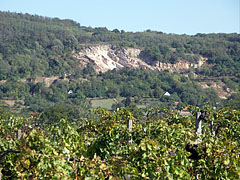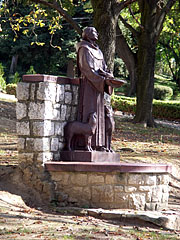(Optimerad för liten skärm enheter)
Pilgrimage Church - Máriagyűd, Ungern
Efter att ha klickat:
Klicka på bilderna!
-

The Roman Catholic Pilgrimage Church of the Visitation of Our Lady in Máriagyűd
Datum för fotografi: 2009-10-032009
Skapat av: Robert Németh
Kameramodell: Konica Minolta Dimage A200
Máriagyűd, Ungern
-

Interior of the Pilgrimage Church
Datum för fotografi: 2009-10-022009
Skapat av: Robert Németh
Kameramodell: Konica Minolta Dimage A200
Máriagyűd, Ungern
-

Statue of Virgin Mary on the neo-baroque main altar
It was created in 1862, made of Siklós "marble" (which is in reality a kind of limestone).
Datum för fotografi: 2009-10-032009
Skapat av: Robert Németh
Kameramodell: Konica Minolta Dimage A200
Máriagyűd, Ungern
-

The baroque Roman Catholic pilgrimage church, dedicated to the Visitation of Our Lady
Built by the Franciscans in 1742
Datum för fotografi: 2009-10-032009
Skapat av: Robert Németh
Kameramodell: Konica Minolta Dimage A200
Máriagyűd, Ungern
-

Towers of the Basilica and Pilgrimage Church of Virgin Mary at the foot of the verdant Tenkes Mountain
Datum för fotografi: 2009-10-032009
Skapat av: Robert Németh
Kameramodell: Konica Minolta Dimage A200
Máriagyűd, Ungern
-

A stone pit (a mine) on the hillside, and in the foreground grapevines can be seen
Datum för fotografi: 2009-10-032009
Skapat av: Robert Németh
Kameramodell: Konica Minolta Dimage A200
Máriagyűd, Ungern
-

Restaurant terrace
Datum för fotografi: 2009-10-032009
Skapat av: Robert Németh
Kameramodell: Konica Minolta Dimage A200
Máriagyűd, Ungern
-

Street view with restaurants and the Pilgrimage Church
Datum för fotografi: 2009-10-032009
Skapat av: Robert Németh
Kameramodell: Konica Minolta Dimage A200
Máriagyűd, Ungern
-

The towers (steeples) of the Pilgrim Church through the trees
Datum för fotografi: 2009-10-032009
Skapat av: Robert Németh
Kameramodell: Konica Minolta Dimage A200
Máriagyűd, Ungern
-

Statue of St. Francis of Assisi (founder of the Franciscan Order) in the garden of the pilgrimage church
Datum för fotografi: 2009-10-032009
Skapat av: Robert Németh
Kameramodell: Konica Minolta Dimage A200
Máriagyűd, Ungern
-
Statue of St. Francis of Assisi
Datum för fotografi: 2009-10-032009
Skapat av: Robert Németh
Kameramodell: Konica Minolta Dimage A200
Máriagyűd, Ungern
Statue of St. Francis of Assisi - Máriagyűd, Ungern -
Statue of Virgin Mary from 1853, with a thanksgiving plaque on it
Datum för fotografi: 2009-10-032009
Skapat av: Robert Németh
Kameramodell: Konica Minolta Dimage A200
Máriagyűd, Ungern
Statue of Virgin Mary from 1853, with a thanksgiving plaque on it - Máriagyűd, Ungern -
The brick-red and white colored baroque church of the Shrine in Máriagyűd
In 2008 it received basilica title from Pope Benedict XVI.
Datum för fotografi: 2009-10-032009
Skapat av: Robert Németh
Kameramodell: Konica Minolta Dimage A200
Máriagyűd, Ungern
The brick-red and white colored baroque church of the Shrine in Máriagyűd - Máriagyűd, Ungern -
Windows of the pilgrim church, and a sundial between them
Datum för fotografi: 2009-10-032009
Skapat av: Robert Németh
Kameramodell: Konica Minolta Dimage A200
Máriagyűd, Ungern
Windows of the pilgrim church, and a sundial between them - Máriagyűd, Ungern -
A sun-dial on the wall of the church
Datum för fotografi: 2009-10-032009
Skapat av: Robert Németh
Kameramodell: Konica Minolta Dimage A200
Máriagyűd, Ungern
A sun-dial on the wall of the church - Máriagyűd, Ungern -
A crest above the door of the church ot the Shrine to the Virgin Mary (or Marian shrine)
Datum för fotografi: 2009-10-032009
Skapat av: Robert Németh
Kameramodell: Konica Minolta Dimage A200
Máriagyűd, Ungern
A crest above the door of the church ot the Shrine to the Virgin Mary (or Marian shrine) - Máriagyűd, Ungern -
Statue of Virgin Mary behind a glass window on the wall of the church (it is called "Ancilla Domini")
Created by Lajos Palkovics in 1979
Datum för fotografi: 2009-10-032009
Skapat av: Robert Németh
Kameramodell: Konica Minolta Dimage A200
Máriagyűd, Ungern
Statue of Virgin Mary behind a glass window on the wall of the church (it is called "Ancilla Domini") - Máriagyűd, Ungern -
The nave of the church with murals, frescoes and the side altars (currently a Holy Mass is going on)
Datum för fotografi: 2009-10-032009
Skapat av: Robert Németh
Kameramodell: Konica Minolta Dimage A200
Máriagyűd, Ungern
The nave of the church with murals, frescoes and the side altars (currently a Holy Mass is going on) - Máriagyűd, Ungern -
The 18th-century baroque side altar of Saint Francis of Assisi
Datum för fotografi: 2009-10-032009
Skapat av: Robert Németh
Kameramodell: Konica Minolta Dimage A200
Máriagyűd, Ungern
The 18th-century baroque side altar of Saint Francis of Assisi - Máriagyűd, Ungern -
Sacred Heart of Jesus Chapel
Datum för fotografi: 2009-10-022009
Skapat av: Robert Németh
Kameramodell: Konica Minolta Dimage A200
Máriagyűd, Ungern
Sacred Heart of Jesus Chapel - Máriagyűd, Ungern -
The interior of the church of Máriagyűd
Datum för fotografi: 2009-10-022009
Skapat av: Robert Németh
Kameramodell: Konica Minolta Dimage A200
Máriagyűd, Ungern
The interior of the church of Máriagyűd - Máriagyűd, Ungern
Klicka på bilderna!
Egenskaper, karakteristika, kännetecken
Läge/plats:
GPS-koordinater: Inte tillgänglig för närvarande
Information, kort berättelser, intressanta fakta
 The brick-red and white colored baroque church of the Shrine in Máriagyűd
The brick-red and white colored baroque church of the Shrine in Máriagyűd
In 2008 it received basilica title from Pope Benedict XVI.
Including the springs near the hill, the surroundings of Máriagyűd was already used by the ancient Romans, it was a resting place on the road between Sopianae and Mursa (so between the present-day Pécs, Hungary and Eszék or Osijek, Croatia). Later Christian Slavs (probably Slovenes) erected an altar here for Virgin Mary, this was then found by Benedictine monks in 1006, who were settled here by (Saint) Stephen I, the first king of Hungary. The monks built a chapel over the altar sculpture, which was replaced by a church in 1148 by the order of King Géza II of Hungary. Over the years it was rebuilt a couple of times, the current huge twin-towered baroque pilgrimage church with the cross groundplan was completed in 1742. However, the statue in the altar is not the original Marian statue, but a 300-year-old another sculpture.
 Statue of Virgin Mary on the neo-baroque main altar
Statue of Virgin Mary on the neo-baroque main altar
It was created in 1862, made of Siklós "marble" (which is in reality a kind of limestone).
The statue on the high altar in the sanctuary of the Pilgrimage Church of Máriagyűd was created in 1713, as well as the silver alloy "mantles" of it in 1784. The statue of Virgin Mary with the Child Jesus in her arms was a donation of the diocesan bishop of Pécs. During the Rákóczi's War of Independence the original Marian statue was carried to Eszék town (the today's Osijek, Croatia). The war was closed by Treaty of Szatmár (present-day Satu Mare, Romania) in 1711. The people of Máriagyűd asked the statue back, but Eszék didn't give it back to them, moreover even the Pope decided unfavorably for them. The old Virgin Mary statue is still there in Eszék (Osijek) town in Croatia.
 Interior of the Pilgrimage Church
Interior of the Pilgrimage Church
The church is a Roman Catholic pilgrimage site since 1805, when the Pope officially recognized it. The so-called Marian apparition (alleged supernatural appearance of the Blessed Virgin Mary) of 1687 played a significant role in it.
After the Ottoman rule the church was first owned by the Greek Orthodox Church, and later by the Calvinist Church. But in 1687 Virgin Mary appeared in a blaze of Heavenly light for a local Roman Catholic farmer, in the window of the church that was then owned by the Calvinists. However, it should be mentioned that the other farmer who was also there and who was Calvinist, quite interestingly did not see anything from the apparition. But the count of Siklós was praying until it turned out that after all the Calvinist farmer somehow saw the apparition. So as usual in most of the religions, there were plenty of conflicts between the different denominations, moreover the waves of the Counter-Reformation were still simmering in Hungary. The long and short of it was that by the intercession of higher lords (so actually by force) the Catholics regained the church from the Calvinists. Later, in around 1757 also an ecclesiastical investigation proved (however by an unspecified way) that the church and its surroundings are a wonderworking, miraculous shrine or sacred place. Since then it is a place of pilgrimage, and many believers come here from all over the world hoping for the physical and spiritual recovery.
In 2008 the church of Máriagyűd received Basilica Minor title from Pope Benedict XVI.
Du kanske också är intresserad av (Relaterade sidor):
Destinationer i reseguide:
Máriagyűd (21 bilder)
Siklós (123 bilder)
Villány-Siklós vindistrikt (223 bilder)
Baranya megye (county) (857 bilder + 4 panorama bilder)
Södra Transdanubien (Dél-Dunántúl) (1 597 bilder + 8 panorama bilder)
Ungern (27 287 bilder + 163 panorama bilder)
och dessutom:
(inom här: Baranya megye och Villány-Siklós vindistrikt och Siklós)
Villány-Siklós vindistrikt (223 bilder)
Mecsek Mountains (304 bilder + 3 panorama bilder)
Szigetvár (330 bilder + 1 panorama bilder)
Harkány (28 bilder)
Siklós (123 bilder)
Nagyharsány (8 bilder)
Palkonya (22 bilder)
Villánykövesd (42 bilder)
Varje panorama foto i:
Máriagyűd ( bilder)
Baranya megye (county) (4 bilder)
Södra Transdanubien (Dél-Dunántúl) (8 bilder)
Ungern (163 bilder)
Europa (165 bilder)
Alla normal bilder i:
Máriagyűd (21 bilder)
Siklós (123 bilder / 3 gallerier)
Villány-Siklós vindistrikt (223 bilder / 8 gallerier)
Baranya megye (county) (857 bilder / 17 gallerier)
Södra Transdanubien (Dél-Dunántúl) (1 597 bilder / 32 gallerier)
Ungern (27 287 bilder / 462 gallerier)
Europa (30 494 bilder / 523 gallerier)
https://www.panadea.com/sv/guidebook/mariagyud/photos/gal-001

Lägg till i Favoriter Lägg till Bokmärke
Dela med dina vänner!
etc.
Om oss - Ansvarsfriskrivning -
Alla rättigheter reserverade
- ©2010-2022
Neuronit Creative Studio - Mogyoród / Budapest / Ungern





